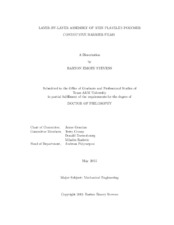| dc.description.abstract | A wide assortment of properties can be achieved in polymer nanocomposites prepared using layer-by-layer assembly. Through aqueous processing in ambient conditions, thin film gas barriers and electrical conductors, for example, can be made to rival films created by more arduous processing techniques, such as vacuum deposition. In this work, polymer/platelet nanocomposite thin films were studied. Montmorillonite clay (MMT) was deposited with pyrene-labeled polyethyleneimine (PEI-Py), which was synthesized and used for its ability to partially self-agglomerate when deposited. This led to denser deposition of layers, allowing the role of density in thin film gas barriers to be probed. Increased density (1.45 vs. 1.24 g/cm^3 for neat PEI films) led to a drastic increase in barrier properties (0.059 vs. 0.75 cm^3/m^2/day/atm) for films of similar thickness (after 12 deposition cycles). When graphene oxide (GO) and PEI were layered and thermally reduced, electrical conductivity (1750 S=m) resulted. Undectable (< 0.005 cm^3/m^2/day/atm) oxygen barrier of GO-based films was realized after ≤ 20 deposited layers in low humidity conditions. At high humidity, films containing reduced GO were more than 100x more effective at blocking O2. These same films were patterned before reduction to form conductive pathways. Patterning was accomplished by exposing the films to a basic solution absorbed in patterned agarose stamps. This wet etching technique was used to remove the GO-based assembly quickly, and SEM confirmed that little material was left behind after etching. GO charge, layer thickness, and resistivity are closely related to pH. As the pH decreases, GO particles become more neutral in solution, confirmed by lower zeta potential, leading to thicker deposition and lower resistivity. | en |


